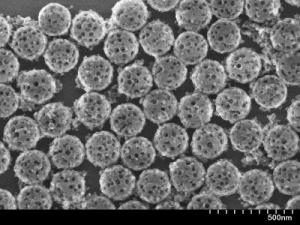Jun 18 2014
Nanoengineers at the University of California, San Diego have developed a nanoshell to protect foreign enzymes used to starve cancer cells as part of chemotherapy. Their work is featured on the June 2014 cover of the journal Nano Letters.
 The enzymes are loaded into the nanoparticle very efficiently through pores on its surface and later encapsulated with a shell of nanoporous silica. The shell's pores are too small for the enzyme to escape but big enough for diffusion of amino acids that feed cancer cells in and out of the particle. The enzymes remain trapped inside where they deplete any amino acids that enter. Credit: Inanc Ortac
The enzymes are loaded into the nanoparticle very efficiently through pores on its surface and later encapsulated with a shell of nanoporous silica. The shell's pores are too small for the enzyme to escape but big enough for diffusion of amino acids that feed cancer cells in and out of the particle. The enzymes remain trapped inside where they deplete any amino acids that enter. Credit: Inanc Ortac
Enzymes are naturally smart machines that are responsible for many complex functions and chemical reactions in biology. However, despite their huge potential, their use in medicine has been limited by the immune system, which is designed to attack foreign intruders. For example, doctors have long relied on an enzyme called asparaginase to starve cancer cells as a patient undergoes chemotherapy. But because asparaginase is derived from a nonhuman organism, E. Coli, it is quickly neutralized by the patient's immune system and sometimes produces an allergic reaction. In animal studies with asparaginase, and other therapeutic enzymes, the research team found that their porous hollow nanoshell effectively shielded enzymes from the immune system, giving them time to work.
Asparaginase works by reacting with amino acids that are an essential nutrient for cancer cells. The reaction depletes the amino acid, depriving the abnormal cells from the nutrients they need to proliferate.
"Ours is a pure engineering solution to a medical problem," said Inanc Ortac (Ph.D. '13), who developed the technology as part of his doctoral research in the laboratory of nanoengineering professor Sadik Esener at UC San Diego Jacobs School of Engineering.
The nanoshell acts like a filter in the bloodstream. The enzymes are loaded into the nanoparticle very efficiently through pores on its surface and later encapsulated with a shell of nanoporous silica. The shell's pores are too small for the enzyme to escape but big enough for diffusion of amino acids that feed cancer cells in and out of the particle. The enzymes remain trapped inside where they deplete any amino acids that enter.
"This is a platform technology that may find applications in many different fields. Our starting point was solving a problem for cancer therapeutics," said Ortac.